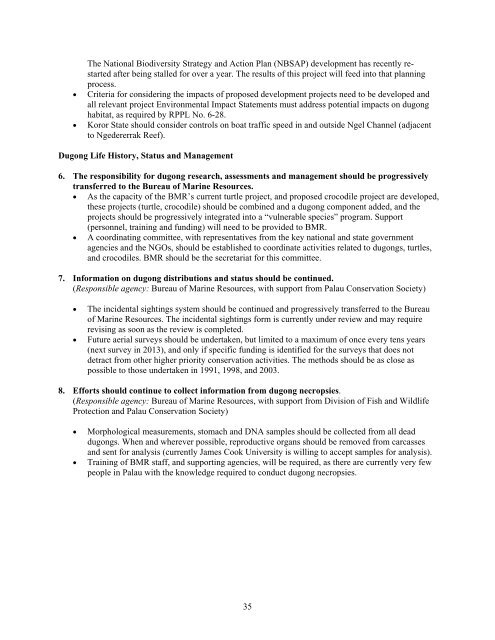dugongs in palau - C3
dugongs in palau - C3
dugongs in palau - C3
You also want an ePaper? Increase the reach of your titles
YUMPU automatically turns print PDFs into web optimized ePapers that Google loves.
The National Biodiversity Strategy and Action Plan (NBSAP) development has recently restarted<br />
after be<strong>in</strong>g stalled for over a year. The results of this project will feed <strong>in</strong>to that plann<strong>in</strong>g<br />
process.<br />
• Criteria for consider<strong>in</strong>g the impacts of proposed development projects need to be developed and<br />
all relevant project Environmental Impact Statements must address potential impacts on dugong<br />
habitat, as required by RPPL No. 6-28.<br />
• Koror State should consider controls on boat traffic speed <strong>in</strong> and outside Ngel Channel (adjacent<br />
to Ngedererrak Reef).<br />
Dugong Life History, Status and Management<br />
6.<br />
The responsibility for dugong research, assessments and management should be progressively<br />
transferred to the Bureau of Mar<strong>in</strong>e Resources.<br />
• As the capacity of the BMR’s current turtle project, and proposed crocodile project are developed,<br />
these projects (turtle, crocodile) should be comb<strong>in</strong>ed and a dugong component added, and the<br />
projects should be progressively <strong>in</strong>tegrated <strong>in</strong>to a “vulnerable species” program. Support<br />
(personnel, tra<strong>in</strong><strong>in</strong>g and fund<strong>in</strong>g) will need to be provided to BMR.<br />
• A coord<strong>in</strong>at<strong>in</strong>g committee, with representatives from the key national and state government<br />
agencies and the NGOs, should be established to coord<strong>in</strong>ate activities related to <strong>dugongs</strong>, turtles,<br />
and crocodiles. BMR should be the secretariat for this committee.<br />
7. Information on dugong distributions and status should be cont<strong>in</strong>ued.<br />
(Responsible agency: Bureau of Mar<strong>in</strong>e Resources, with support from Palau Conservation Society)<br />
• The <strong>in</strong>cidental sight<strong>in</strong>gs system should be cont<strong>in</strong>ued and progressively transferred to the Bureau<br />
of Mar<strong>in</strong>e Resources. The <strong>in</strong>cidental sight<strong>in</strong>gs form is currently under review and may require<br />
revis<strong>in</strong>g as soon as the review is completed.<br />
• Future aerial surveys should be undertaken, but limited to a maximum of once every tens years<br />
(next survey <strong>in</strong> 2013), and only if specific fund<strong>in</strong>g is identified for the surveys that does not<br />
detract from other higher priority conservation activities. The methods should be as close as<br />
possible to those undertaken <strong>in</strong> 1991, 1998, and 2003.<br />
8. Efforts should cont<strong>in</strong>ue to collect <strong>in</strong>formation from dugong necropsies.<br />
(Responsible agency: Bureau of Mar<strong>in</strong>e Resources, with support from Division of Fish and Wildlife<br />
Protection and Palau Conservation Society)<br />
• Morphological measurements, stomach and DNA samples should be collected from all dead<br />
<strong>dugongs</strong>. When and wherever possible, reproductive organs should be removed from carcasses<br />
and sent for analysis (currently James Cook University is will<strong>in</strong>g to accept samples for analysis).<br />
• Tra<strong>in</strong><strong>in</strong>g of BMR staff, and support<strong>in</strong>g agencies, will be required, as there are currently very few<br />
people <strong>in</strong> Palau with the knowledge required to conduct dugong necropsies.<br />
35











